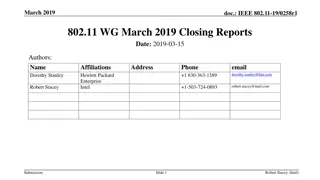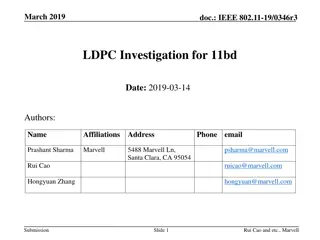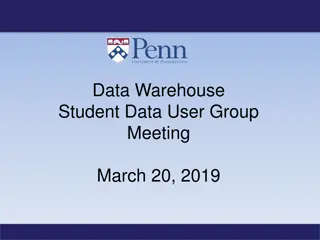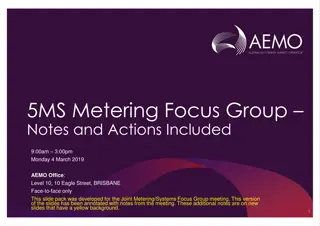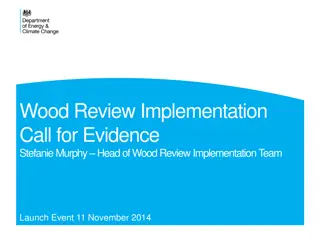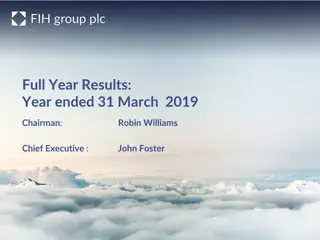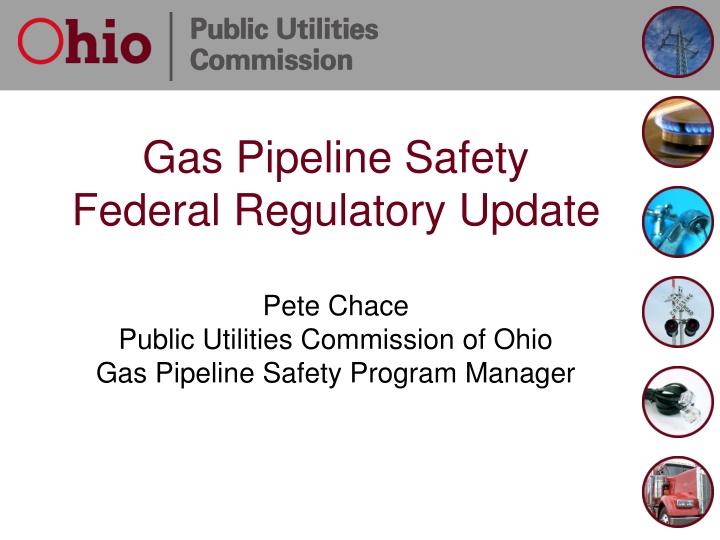
Gas Pipeline Safety and Regulatory Updates in Ohio
Stay informed on the latest gas pipeline safety updates in Ohio, including recent incidents, regulatory actions by the Public Utilities Commission, and NTSB recommendations. Learn about the importance of a Management of Change program in ensuring operational safety and compliance.
Download Presentation

Please find below an Image/Link to download the presentation.
The content on the website is provided AS IS for your information and personal use only. It may not be sold, licensed, or shared on other websites without obtaining consent from the author. If you encounter any issues during the download, it is possible that the publisher has removed the file from their server.
You are allowed to download the files provided on this website for personal or commercial use, subject to the condition that they are used lawfully. All files are the property of their respective owners.
The content on the website is provided AS IS for your information and personal use only. It may not be sold, licensed, or shared on other websites without obtaining consent from the author.
E N D
Presentation Transcript
Gas Pipeline Safety Federal Regulatory Update Pete Chace Public Utilities Commission of Ohio Gas Pipeline Safety Program Manager
Low Pressure Systems Recent accident in Andover MA resulting in over- pressurization of approximately 6,000 customers, one fatality. Cause was isolation and depressurization of a segment of the LP system connected to the regulator station control lines.
LP Systems PUCO action Developed a LP System Survey to inventory Ohio LP systems and assess design, operation & maintenance practices. Relied on in-house knowledge and AGA Recommended Best Practices for LP systems to develop the Survey Approximately 920,000 Ohio customers served by LP systems Rule revision considerations.
LP Systems Preliminary NTSB Recommendations Require a professional engineer s seal on public utility engineering drawings. (P-18-005) Revise the engineering plan and constructability review process across all of your subsidiaries to ensure that all applicable departments review construction documents for accuracy, completeness, and correctness, and that the documents or plans be sealed by a professional engineer prior to commencing work. (P-18-006) Review and ensure that all records and documentation of your natural gas systems are traceable, reliable, and complete. (P-18-007)
LP Systems Preliminary NTSB Recommendations Apply management of change process to all changes to adequately identify system threats that could result in a common mode failure. (P-18-008) Develop and implement control procedures during modifications to gas mains to mitigate the risks identified during management of change operations. Gas main pressures should be continually monitored during these modifications and assets should be placed at critical locations to immediately shut down the system if abnormal operations are detected. (P-18-009)
What is Management of Change ? The objective of a Management of Change (MOC) program is to ensure all changes to a process are properly reviewed and hazards introduced by the change are identified, analyzed, and controlled prior to resuming operation. A MOC program must specify what types of changes are to be managed, for example, physical alterations to equipment or new operating procedures. Procedures for managing these changes should be written and regularly reviewed. Employees, as well as maintenance and contract workers whose work will be affected by the change, must be informed and trained on the new equipment, process or whatever the change includes.
Recommended Best Practices Station Design GPS Staff believes the best way to prevent LP system over-pressurization is to install backup relief valves on each LP system. Other options to consider: Additional monitoring regulation Slam shut valves Customer service regulation Review and standardize design templates, with approval from subject matter experts.
Recommended Best Practices Station Design Design systems to minimize response time. Consider system design that allows for remote control. Design to minimize possibility of common failures: Protect sensing lines Design to minimize possible vent line and relief valve obstructions Mitigate possible gas contamination / fluids
Recommended Best Practices Operations & Maintenance Complete records and drawings should be retained and documented. Know where your buried control lines are. Remote monitoring and alarms are nice but may not allow you to react quickly enough. Excavation in the vicinity of buried control lines should be identified as a higher priority call ticket. Additional precautions when planning and performing tie-ins and uprates.
Recommended Best Practices Operations & Maintenance Written procedures for maintenance tasks. Training should explain why the procedures say what they say. Procedures should be followed. Monitor pressure during procedures Ensure valves are in working order prior to beginning work Conduct a pre-job briefing Be aware of work that could create debris Consider a lock-out/tag-out program
Recommended Best Practices Construction Projects should be planned, reviewed by a qualified person with knowledge of the system. Employees with system expertise should attend design/construction prep meetings when appropriate. Verify correct location of control lines, services and mains, mark the work site Keep projects to a manageable size Clear delineation of authority during work who is in charge of what?
Recommended Best Practices Records Management Have a documented process for creation, collection, identification, distribution, and storage of records. Precise location information is important Update maps and records in a timely fashion for both as-built markups and field changes Make maps and records available for engineering, construction, and maintenance personnel
LP Systems Past Incidents Burlington IA excavation damage to control lines Gary IN Improper operation of a separation valve between a LP and a MP system. Centralia MO excavation damage to control lines
LP Systems Past Incidents East Boston MA regulator failure when a vault filled up with water. Chicago IL no one was monitoring downstream pressure during a regulator inspection. Fairport Harbor OH regulator failure due to pipeline fluid buildup in monitor regulators.
Upcoming PHMSA Rule Amendments Transmission / Gathering Rule expected to be released this year. Broken into 3 parts. NPRM Valve installation and Minimum Rupture Detection Standards (NPRM projected date 8/7/19) NPRM Gas Pipeline Regulatory Reform. Amend Regulations to ease regulatory burdens on construction and operation of pipeline systems. Pub date 8/14/19, comment period till 10/14/19
Upcoming PHMSA Rule Amendments ANPRM for Class Location Requirements perform IM measures when class location changes instead of reducing pressure, pressure testing, or replacement. Comments in 10/1/18 Plastic Pipe rule current stay of enforcement Farm Taps potential stay of enforcement Underground Storage Facilities goal for final rule is publish 7/2/19, effective 8/2/19 Enhanced Emergency Order Procedures final rule effective date 4/19/19
Gas Transmission / Gathering In Development Response to Congressional mandates in the 2011 Pipeline reauthorization act. NPRM released 3/15/2016 PHMSA received over 400 comments Rule went through a period of revision and modification PHMSA is breaking the rule into 3 parts
Gas Transmission / Gathering Part 1 (expected July 2019) Expanded record requirements MAOP reconfirmation Material verification Expansion of IM assessments outside of HCA s and other related issues
Gas Transmission / Gathering Part 1: Records Requirements Operators must acquire and retain for the life of the pipeline the original steel pipe manufacturing records for yield strength, tensile strength, and chemical composition of materials. Operators must make and retain for the life of the pipeline records documenting pipe design to withstand external pressures and loads in accordance with 192.103 and determination of design pressure in accordance with 192.105.
Gas Transmission / Gathering Part 1: MAOP Reconfirmation Piping without records needed to establish MAOP per 192.619 (a) through (e) must reconfirm MAOP if it is in a HCA or Class 3, 4 location. Pipe segments with a past pressure test meeting Subpart J and records demonstrating compliance with 192.619(a)(2) do not require reconfirmation. Methods are pressure reduction, pressure testing, engineering critical assessment , pipe replacement Less restrictive pressure reduction criteria specified for low stress piping. Covered in a new 192.624.
Gas Transmission / Gathering Part 1: Material Verification Applies to same piping as MAOP reconfirmation Should be an opportunistic sampling approach Verify material properties as opportunities present themselves during the course of normal operations and maintenance Allows for non-destructive testing where feasible Covered in a new 192.607
Gas Transmission / Gathering Part 1: IM Expansion Expansion of risk assessment obligation to include areas in non-HCA s and Moderate Consequence Areas (MCA). MCA includes a Potential Impact Radius (PIR) containing 5 or more residences, or an Occupied Site.
Gas Transmission / Gathering Part 1: other changes 6 month grace period for 7-calendar year IM reassessment intervals Consideration of seismicity for IM assessments MAOP exceedance reporting Codifies some of the risk modeling requirements in B31.8S Provides guidance on Guided Wave Ultrasonic Testing (GWUT).
Gas Transmission / Gathering Part 2 (December 2019) Adjustments to repair criteria for pipelines in HCA s and non-HCA s. Inspections following extreme weather events Corrosion control improvements (DCVG/ACVG gradient survey for new construction, CIS for low reads, interference surveys around HVAC power lines, internal corrosion monitoring) More detail to Internal Corrosion control requirements.
Gas Transmission / Gathering Part 2 (December 2019) Safety features on in-line inspection launchers and receivers Management of change requirements as outlined in ASME B31.8S Other IM clarifications and increased assessment requirements
Gas Transmission / Gathering Part 3 (December 2019) Reporting requirements for Gathering lines MAOP and leak repair for all Gathering Safety regulations extended to some gas gathering lines in Class 1 locations. Requirements are basically the same requirements as in the Ohio Gas Gathering rule. Type of piping it applies to may be different (focusing on pipe diameter and pressure) Gathering related definitions
Plastic Pipe Rule Originally effective Jan 22, 2019 AGA requested a stay of enforcement due to concerns about the availability of certain components and for time to develop procedures for weak links, plastic pipe storage and handling, and pipe fusion equipment maintenance & upkeep Rule will be phased in over the next year
Plastic Pipe Rule Highlights PE pipe can have a design pressure of up to 125 psig, PA-11 and 12 pipe up to 250 psig for certain manufacture dates, pipe size, wall thickness, material specification. Design requirements for plastic risers. Requirement that mechanical joints and fittings be able to resist pullout force ( category 1 ) Pipe pulled through the ground must use a weak link
Plastic Pipe Rule Highlights May not use mechanical leak repair clamps as a permanent repair on plastic pipe Must have written procedures for the storage and handling of plastic pipe Have to maintain joining equipment in accordance with written procedures and/or manufacturers recommendations.
Findings from Field Inspections Most common violations found: 192.13(c)/605 Not following procedures in the field. 192.805 Operator Qualifications 192.479/481 Atmospheric Corrosion Various code sections associated with External Corrosion monitoring and prevention Other items for discussion: Fusion joint documentation DIMP requirement for system knowledge Drug & Alcohol
Notes on OQ Findings from the NY state program regarding East Harlem explosion in 2014: Operator accountability lacking for all individuals working on their system (i.e. operators don t know what some their contractors are being taught). OQ training does not focus on the performance of covered tasks using specific operator procedures and operator equipment. Too much reliance on written examinations, inadequate operator oversight of exams. Our environment is different, but we can learn some things from their experience.
Incident Trends What do incident trends tell us about pipeline safety threats? Excavation Damage is still the top threat for Distribution piping. Other Outside Force Damage (i.e. cars) are close behind. Material/weld/joint failure and Corrosion are the top threats for Transmission lines For Transmission lines in eastern Ohio, soil shifting and landslides are a significant risk.
Annual Report Excavation Damages
Statewide Trends Statewide root causes (2015-2017): One Call practices not sufficient 23% Locating practices not sufficient: 35% Excavation practices not sufficient: 36% Other: 6% Categories can and should be broken down more finely. Ex: Common Ground Alliance DIRT report.
From DIRT Field Form *Part I Description of the Root Cause *Please choose one One-Call Notification Practices Not Sufficient Locating Practices Not Sufficient No notification made to the One-Call Center Notification to one-call center made, but not sufficient Wrong information provided to One Call Center Excavation Practices Not Sufficient Failure to maintain marks Failure to support exposed facilities Failure to use hand tools where required Failure to test-hole (pot-hole) Improper backfilling practices Failure to maintain clearance Other insufficient excavation practices Facility could not be found or located Facility marking or location not sufficient Facility was not located or marked Incorrect facility records/maps Miscellaneous Root Causes One-Call Center error Abandoned facility Deteriorated facility Previous damage Data Not Collected Other
Questions? Pete Chace (614) 644-8983 Peter.chace@puc.state.oh.us




